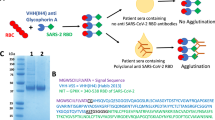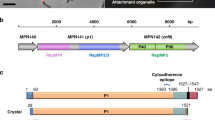Abstract
THE principle of mixed agglutination1 has been used by Högman2 to indicate the presence of blood-group antigens in tissue culture. In this system the cultured cells are sensitized with antibodies directed towards antigens of the cell surface. Thereby the cells acquire capacity to adsorb homologous red cells. Vogel and Shelokov3 have shown that certain viruses can be located in tissue cultures by their capacity to adsorb sensitive erythrocytes, the so-called hæmadsorption test. Two pre-requisites for this system are : (1) that virus antigen be available on the surface of the infected tissue cells; (2) that this antigen fix the erythrocytes.
This is a preview of subscription content, access via your institution
Access options
Subscribe to this journal
Receive 51 print issues and online access
$199.00 per year
only $3.90 per issue
Buy this article
- Purchase on Springer Link
- Instant access to full article PDF
Prices may be subject to local taxes which are calculated during checkout
Similar content being viewed by others
References
Coombs, R. R. A., and Bedford, D., Vox Sang., 5, 111 (1955).
Högman, C., Vox Sang., 9, 12 (1959).
Vogel, J., and Shelokov, A., Science, 126, 358 (1957).
Boyden, S. V., J. Exp. Med., 93, 107 (1951).
Author information
Authors and Affiliations
Rights and permissions
About this article
Cite this article
FAGRAEUS, A., ESPMARK, Å. Use of a ‘Mixed Hæmadsorption’ Method in Virus-infected Tissue Cultures. Nature 190, 370–371 (1961). https://doi.org/10.1038/190370a0
Issue Date:
DOI: https://doi.org/10.1038/190370a0
This article is cited by
-
Serologic identification of the species of origin of cells in tissue culture by means of the mixed hemadsorption reaction
Tissue Culture Association Manual (1976)
-
Gesteigerte Immunogenit�t von Plasmamembranen vaccinia virusinfizierter BHK-Zellen
Archiv f�r die gesamte Virusforschung (1973)
Comments
By submitting a comment you agree to abide by our Terms and Community Guidelines. If you find something abusive or that does not comply with our terms or guidelines please flag it as inappropriate.



